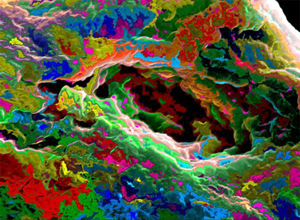I had been looking for a way to help folks understand some of the basic re: nanotechnology and molecular manufacturing when I had an epiphany: how better than to let the experts talk.
Hence, the following, and interview I did with Mike Treder and Chris Phoenix, co-founders of the Center for Responsible Nanotechnology (crnano.org).
Treder and Phoenix are leaders in an attempt to both understand the potential for molecular manufacturing and plan for the many roads it may lead us down. They are among a handful of intelligent, forthright and dedicated individuals who have made it their mission in life to look for safe paths that lead to benefits for all the world’s people and downside outcomes for none.
RR: Please describe the difference between molecular manufacturing and other kinds of nanotechnology.The basic difference is that molecular manufacturing aims to achieve direct programmable control of reactions between individual molecules. Other kinds of nanotechnology produce small and useful objects, but they do it with equipment that is very limited in its ability to inject information to the nanoscale. Most nanotech products are small, simple, or both.
Molecular manufacturing is an approach that connects information technology directly to the nanoscale.
Programmable construction of molecular tools will create new ways to manipulate the nanoscale. The smaller the tools, the more material they can process per second-especially relative to their size. Also, the inherent precision of molecule-forming reactions will make it easier to build precise and highly functional products. As the tools shrink and improve, molecular manufacturing will become able to build its own construction equipment. This "nano building nano" approach will allow rapid scaleup of production capacity: exponential manufacturing. Although even primitive molecular manufacturing will be useful, the achievement of exponential manufacturing will be revolutionary.
RR: Do you see the development of that sort of molecular manufacturing as a natural progression from today's nanotech research, or will it require significant new scientific breakthroughs?We see it as a natural progression. The main breakthrough needed is not in science, but in scientists: the recognition that molecular manufacturing is a very powerful approach to the nanoscale. This is not to downplay the work that will be required to develop it. But we're close to the point, if not already there, where molecular manufacturing can be developed by a very large-scale engineering effort comparable to the Manhattan Project.
Although the goals and methods of molecular manufacturing are straightforward applications of today's science, the achievement of exponential manufacturing could be a very significant practical milestone. The
products it could build will depend on the choice of materials and the sophistication of the software. But from what we know so far, it looks like new and powerful products could be developed
too quickly for sensible policymaking.
RR: Which kind of nanotechnology has the most significant near-term and long-term concerns, and what are they?There are two basic concerns associated with today's nanoscale technologies. One is that any powerful technology can have undesirable societal effects. The other concern associated with nanoscale technologies is that some of those technologies produce nanoparticles, and some kinds of nanoparticles are unknown and possibly hazardous classes of chemicals. Industry and regulators should not assume that nanoparticles are safe, and the public and special interest groups should not assume that nanoparticles are dangerous. Ordinary smoke and dirt have been full of nanoparticles for billions of years. But even when they're made of familiar materials, nanoparticles can have new properties that mean they should be treated like any other unfamiliar chemical.
The real nanotechnology revolution will begin with the shift from the production of new materials and products to the production of new systems of production. When we achieve the ability to do automatic, programmed, atomically-precise manufacturing, and when those new systems of production can, on command, produce copies of themselves, then we will have entered the age of exponential general-purpose molecular manufacturing. We expect this to occur ten to fifteen years from now, though with sufficient effort it could conceivably happen in
less than ten years.
But when it comes, it will be dramatically transformative. All areas of society will be affected, and unless adequate preparations are made, the economic and geopolitical destabilization could be
severely disruptive.
Read the full interview here
http://www.nanotech-now.com/products/nanonewsnow/issues/020/020.htmCenter for Responsible NanotechnologyOur VisionAdvanced nanotechnology may build machines that are thousands of times more powerful—and hundreds of times cheaper—than today's devices. The humanitarian potential is enormous; so is the potential for misuse. The vision of CRN is a world in which molecular manufacturing is widely used for productive and beneficial purposes, and where malicious uses are limited by effective administration of the technology.
Our MissionCRN acts to raise awareness of the issues. We believe that even a technology as powerful as molecular manufacturing can be used wisely and well—but that without adequate information, unwise use will be far too common. The mission of CRN is to raise awareness of the issues presented by nanotechnology: the benefits and dangers, and the possibilities for responsible use.
Our PurposeIn order to provide well-grounded and complete information, clear explanation, and workable proposals, CRN studies, clarifies, and researches the issues involved—political, economic, military, humanitarian, and technological. CRN presents the results for both technical and popular audiences, and works to supply the information as effectively as possible. The purpose of CRN is to investigate the ethical, legal, and social implications (ELSI) of molecular manufacturing, and to educate those who will influence its use or be affected by it.
To learn more, visit these links
Timeline for Molecular Manufacturing
http://www.crnano.org/timeline.htmBridges to Safety, and Bridges to Progress
http://www.crnano.org/Bridges.htmThirty Essential Nanotechnology Studies
http://www.crnano.org/studies.htm










